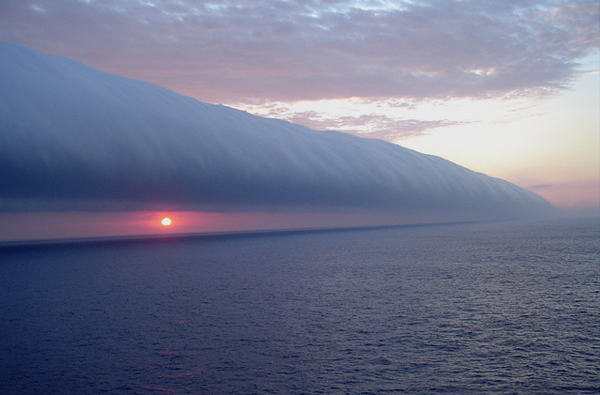From “Earthweek – A Diary of the Planet: Weekly News” that is featured on our web site at as part of “Earth Gate” which includes a weekly environmental news map and short descriptions of major events occurring around the world:
Australia’s Morning Glory: Earth Image of the Week August 28, 2009
Very rare meteorological phenomena known as Morning Glory clouds have been observed at various locations around the world. But only those occurring near Australia’s Gulf of Carpentaria can accurately be predicted in advance around this time of year. As seen in the image to the right, Morning Glory clouds are narrow tubes. They often form in a series and can be up to 600 miles long.
The Morning Glory is technically known as a solitary wave cloud, or a soliton, which is a self-reinforcing wave that has a single crest and moves without changing speed or shape. The unique shape, size and orientation of the Cape York Peninsula, adjacent to the Gulf of Carpentaria, is responsible for what are believed to be the world’s most impressive Morning Glory clouds. The peninsula is large enough that the daytime heating of its interior pulls in sea breezes from both the Coral Sea to the east and the Gulf of Carpentaria to the west. A line of clouds forms over the spine of the peninsula where the two sea breeze fronts collide.
While the complex phenomenon is not entirely understood, meteorologists believe a temperature inversion that forms overnight above the peninsula creates a difference of air density on each side of the line of moisture where the two sea breezes have merged. This causes an atmospheric wave, or series of waves, to roll off the peninsula and over the gulf. Rising air on the advancing side of the wave causes the air to saturate and create a visible cloud. Descending air on the back of the wave causes the cloud to evaporate.
The best place to observe Australia’s Morning Glory is from the remote outpost of Burketown in far northern Queensland between late August through October. Hang gliders from around the world gather there at this time of year to attempt to “surf” at least one of the rolling clouds. Only a few dozen pilots can claim bragging rights to achieving that feat.
For more on this subject, see http://en.wikipedia.org/wiki/Morning_Glory_cloud and http://cloudappreciationsociety.org/





